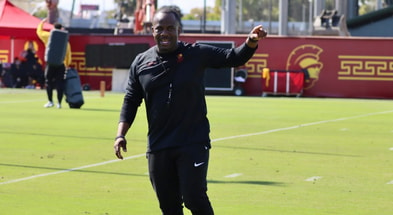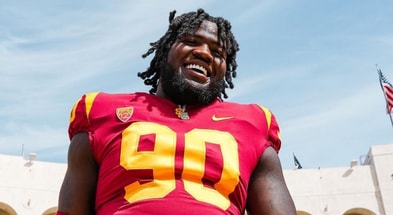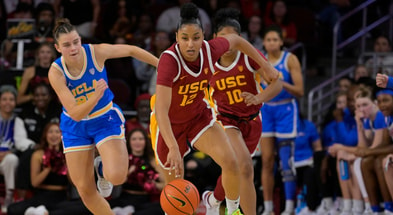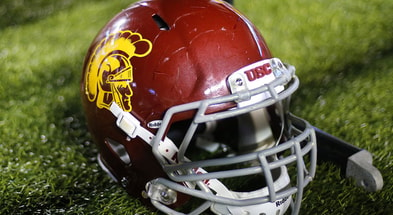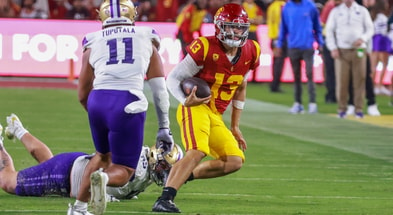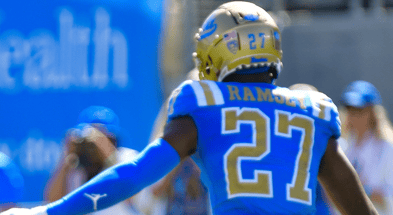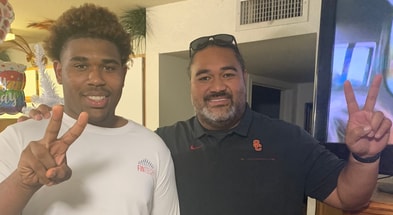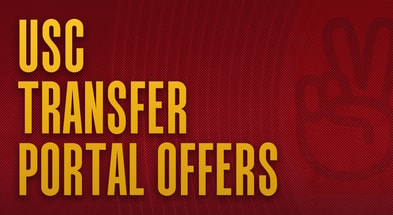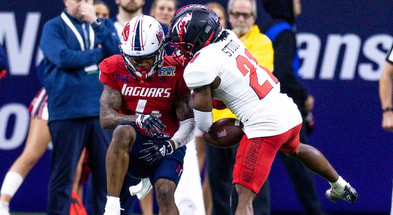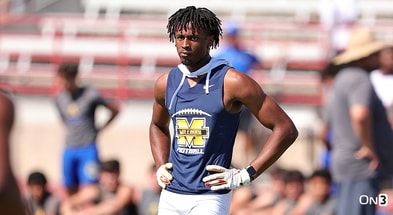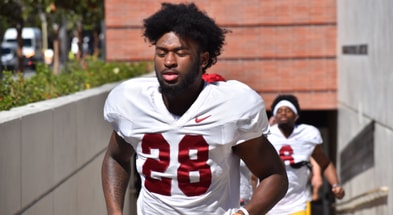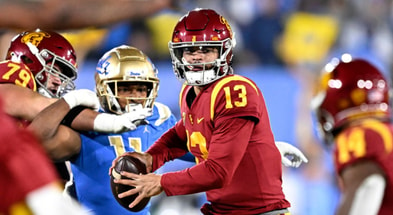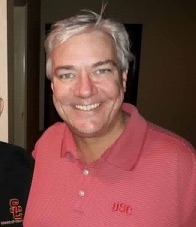Trojans at the bye week
While it isn’t quite the official midpoint of the 2019 season, the bye week still feels like an appropriate time to recap the first part of the year, and to look at where the USC Trojans stand in terms of what’s gone wrong and what’s gone right.
No discussion about the 2019 season can occur without first mentioning the quarterback position. After a four-man battle throughout spring and fall, JT Daniels emerged as the starter, followed by true freshman Kedon Slovis, with Matt Fink at No. 3 and Jack Sears at No. 4. Not long after, Sears announced his intention to transfer. Not long after that, Daniels went down hard at the end of the first half of the season opener against Fresno State, suffering a knee injury that would sideline him for the season.
Slovis took over for Daniels, but then he was knocked out and suffered a concussion two plays into the season’s fourth game, as Fink stepped in. As the Trojans now prepare for Game No. 6, Slovis will return as the starter, so long as he is medically cleared to return.
In terms of the overall 3-2 record, there isn’t much surprise. This looked like it would be a tough open to the season, with some massive conference and non-conference challenges through the first half of the year. Where the surprise comes in is that USC took care of business against Stanford and Utah, but dropped a road game against BYU in overtime.
The Trojans are now 0-2 on the road this year, with another big trip looming in South Bend, Indiana.
Offensively, things have been hit-or-miss. New offensive coordinator Graham Harrell came to USC with a plan and a pass-first scheme, whether or not calling it the Air Raid was the correct nomenclature. Harrell has been hamstrung by having to play three quarterbacks over the first four games of the season, which seemingly hasn’t allowed any of them to gain enough game reps to develop the deep understanding of the offense that Harrell wants from his quarterback.
Heading into the sixth game, it’s far from ideal when your starting quarterback has fully completed just six of 20 quarters.
While there are questions as to how successful this offense has been overall, what’s clear is that it is a significant step up from what was produced in 2018.
USC ranks eighth in the Pac-12 in total offense at this point, compared to finishing tenth in 2018. Despite playing with three different quarterbacks, USC’s total offense per game has increased from 382.6 last year, to 429.4 yards per game this season. There has been a small uptick in the ground game, as USC is at 137.2 yards per game on the ground, compared to 133.5 last year. The conference rankings are the same there, as the Trojans sit at No. 8 this year and finished No. 10 last season.
Through the air, USC ranks No. 4 in the conference in passing yards per game after finishing No. 6 last year. So far, USC is throwing for 43.1 yards per game more this year than last. But there has been a sharp increase in interceptions, as USC finished with just 10 interceptions last season and has already thrown nine this year — three more than any other team in the conference.
Overall, the offensive line has been a pleasant surprise, giving the quarterbacks time to throw and creating running lanes on occasion. Of course, there are some sizable issues that can be brought up as well, as they’ve allowed two quarterbacks to be knocked out of games — the season in Daniels’ case — and couldn’t quite tilt the field enough against the BYU three-man front and Utah’s very talented four-man defensive line. This offensive line will get another tough test from Notre Dame next week.
Not surprisingly, the Trojans offense has been led by its wide receivers. Michael Pittman is No. 1 in the Pac-12 with 35 receptions, while Tyler Vaughns checks in at No. 3, with 31, and Amon-Ra St. Brown’s 24 catches are good for No. 8. Pittman and Vaughns rank No’s. 2 and 4 in receiving yards in the conference.
The Trojans have yet to truly get the tight ends involved in the passing game, and that might be made more difficult now as Josh Falo will be sidelined for a bit with an MCL sprain.
At running back, the Trojans have used Vavae Malepeai as the leader — his 79 carries rank fifth in the conference, and his 360 yards rank No. 8. Stephen Carr has chipped in 31 carries for 189 yards, as he has been a little bit feast-or-famine this season, with a few long runs carrying the average against a lot of runs for little or no gain. And Markese Stepp is starting to come on as well, as he is up to 25 carries on the season, and is likely to see his role increase as the year goes on.
It will be fascinating to see how opponents line up as they defend the Trojans moving forward. BYU and Washington were just fine showing five and six defenders in the box and daring USC to run. While the Trojans put up good rushing numbers against those two teams, USC also threw three interceptions in each game and could never take either one of them over via the running game. It wouldn’t be surprising to see future defenses use that same tactic in daring the Trojans to try to beat them using the ground game. We’ll find out if Slovis or Fink can learn from their mistakes and control the passing game against eight-man drops, or if the Trojans can crank up the running game to deliver big plays against undermanned fronts.
Defensively, there are overall concerns, but the unit has performed more than adequately through five games. It still feels like the Trojans won’t be able to win a game when the offense falters badly, as every opponent has scored at least 20 points this season. But it should also be said that it feels like the defense has done enough on its own to keep USC in, and potentially win, every game this year.
The perimeter defense became a concern several plays into the season-opener against Fresno State and has remained a concern through five games. Teams are unwilling to test the combination of Marlon Tuipulotu and Jay Tufele in the middle of the defensive line, and they have been able to take advantage of a mix of lack of containment by USC edge players, poor angles by linebackers coming inside out, and secondary players not able to set a hard edge and force the play back inside.
But different than the offense, the numbers have been a bit worse this year. USC ranks No. 7 in total yards allowed, compared to No. 6 in 2018, the Trojans are allowing 23.7 more yards per game this season. That different is split fairly evenly on the ground and through the air, as USC is giving up 10.6 more yards per game via the run, and 13.1 through the air.
Linebacker John Houston Jr. leads the team with 45 tackles, and safety Talanoa Hufanga — despite missing the Washington game with a concussion — ranks second with 42. Linebacker Palaie Gaoteote checks in just behind Hufanga with 41 stops.
True freshman Drake Jackson leads the team with 5.5 tackles for loss and three sacks, including a safety against Utah.
Cornerback Olaijah Griffin — again, despite missing the Washington game due to injury — leads the team with six pass deflections.
Safety Isaiah Pola-Mao and nickelback Greg Johnson have USC’s two interceptions, as the Trojans haven’t yet shown that they will surpass last year’s four interceptions on the season. The Trojans have forced four fumbles (Tuipulotu, Jackson, Johnson and Max Williams) and recovered four as well (Johnson, Chris Steele, Hunter Echols and Juliano Falaniko).
Moving forward, the rest of the season will likely be about the Trojans figuring out how to limit the outside runs opponents have been hitting against them. It’ll require making quicker reads and finishing tackles without allowing yards after contact. The players and coaches certainly understand the issues that need to be corrected. Now it will be about following through.
Special teams units have averaged out to being about average for the Trojans. There have been some big plays, as Velus Jones has a kickoff return for a touchdown and USC has blocked two field goals this season. Kicker Chase McGrath is 4-for-4 this season, with a make from 52 yards. Ben Griffiths has three punts of more than 50 yards and has forced fair catches on 13 of his 19 punts. And the two Trojan kickoff specialists have 16 touchbacks on 28 kickoffs.
But there have been a few gaffes as well — most notably, the kickoff return team getting flagged for having two players wearing the same uniform number on the first play of the season. Even with Jones’ 100-yard return, the Trojans are averaging fewer than 23 yards per kickoff return, compared to 24.4 for opponents. And Griffiths has hit seemingly more than his share of short punts, averaging just over 40 yards per punt, compared to nearly 45 yard per punt for opponents, while the Trojans are averaging about half of what opponents are on punt returns.
Ultimately, the Trojans sit behind undefeated Arizona and Colorado in the Pac-12 South right now. But with those teams still on the schedule, USC still controls its own destiny as far as reaching the conference championship game. While there are some adjustments that need to happen in all three phases for the Trojans to be considered a real contender when it comes to the conference race, we’ve seen them be able to put it all together in spurts this season. It’ll be about toughness, consistency and production over the final seven games, and it starts next weekend against the Fighting Irish.
